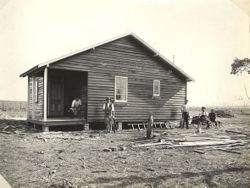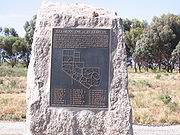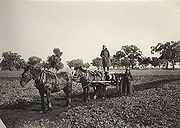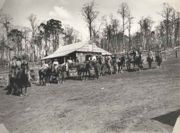
Soldier settlement (Australia)
Encyclopedia

Australia
Australia , officially the Commonwealth of Australia, is a country in the Southern Hemisphere comprising the mainland of the Australian continent, the island of Tasmania, and numerous smaller islands in the Indian and Pacific Oceans. It is the world's sixth-largest country by total area...
by returning discharged soldiers under schemes administered by the State Governments after World Wars I and II.
World War I
Such settlement plans initially began during World War IWorld War I
World War I , which was predominantly called the World War or the Great War from its occurrence until 1939, and the First World War or World War I thereafter, was a major war centred in Europe that began on 28 July 1914 and lasted until 11 November 1918...
, with South Australia
South Australia
South Australia is a state of Australia in the southern central part of the country. It covers some of the most arid parts of the continent; with a total land area of , it is the fourth largest of Australia's six states and two territories.South Australia shares borders with all of the mainland...
first enacting legislation in 1915 but the whole of Australia gaining significant impetus to also move in that direction when in February 1916 a conference of representatives of both the Commonwealth and the States was held in Melbourne
Melbourne
Melbourne is the capital and most populous city in the state of Victoria, and the second most populous city in Australia. The Melbourne City Centre is the hub of the greater metropolitan area and the Census statistical division—of which "Melbourne" is the common name. As of June 2009, the greater...
to consider a report prepared by the Federal Parliamentary War Committee regarding the settlement of returned soldiers on the land. The report focused specifically on a Commonwealth-State cooperative process of selling or leasing Crown land to soldiers who had been demobilised
Demobilization
Demobilization is the process of standing down a nation's armed forces from combat-ready status. This may be as a result of victory in war, or because a crisis has been peacefully resolved and military force will not be necessary...
following the end of their service in this first global conflict. The meeting agreed that it was the Commonwealth Government's role to select and acquire land whilst the State government authorities would process applications and grant land allotments.
Crown land
Crown land
In Commonwealth realms, Crown land is an area belonging to the monarch , the equivalent of an entailed estate that passed with the monarchy and could not be alienated from it....
was used where possible, but much land was acquired. By 1924, just over 24 million acres (97,000 km²) had been acquired or allocated. Of this nearly 6.3 million acres (25,000 km²) was purchased and 18 million acres (73,000 km²) was crown land set aside. 23.2 million acres (93,900 km²) had been allotted 23,367 farms across Australia.
Other than supporting soldiers and sailors that were returning from those wars the various governments also saw the opportunity of attracting both Australians and specific groups of allied
service personnel to some of the otherwise little inhabited, remote areas of Australia. Although the Commonwealth held responsibility for defence, and thus might have taken responsibility for demobilised soldiers, it was the States which took responsibility for land settlement and thus enacted separate soldier settlement schemes. The States also wished to take an active role in recognising the contribution of soldiers.
Areas that gained such settlement included places such as Merbein
Merbein, Victoria
Merbein is a town outside Mildura, Victoria, in the Sunraysia region of Australia. At the 2006 census, Merbein had a population of 2526.The area was known as White Cliffs until 1909 when the township was established, the Post Office opening on 16 August 1909.The name was intended to be Merebin,...
and Mortlake
Mortlake, Victoria
Mortlake is a town in the Western District of Victoria, Australia on the Hamilton Highway, north-east of Warrnambool. It is in the Shire of Moyne local government area and the federal Division of Wannon...
in Victoria
Victoria (Australia)
Victoria is the second most populous state in Australia. Geographically the smallest mainland state, Victoria is bordered by New South Wales, South Australia, and Tasmania on Boundary Islet to the north, west and south respectively....
; Griffith
Griffith, New South Wales
Griffith is a city in south-western New South Wales, Australia. It is also the seat of the City of Griffith local government area. Like the Australian capital, Canberra and the nearby town of Leeton, Griffith was designed by Walter Burley Griffin. Griffith was named after Sir Arthur Griffith the...
and Dorrigo
Dorrigo, New South Wales
Dorrigo is a small town located on the Waterfall Way in northern New South Wales, Australia. It is approximately 580 kilometres north of the state capital, Sydney via the Pacific Highway, and 60 kilometres from the coastal city of Coffs Harbour. The town is situated on the Dorrigo Plateau near the...
in New South Wales
New South Wales
New South Wales is a state of :Australia, located in the east of the country. It is bordered by Queensland, Victoria and South Australia to the north, south and west respectively. To the east, the state is bordered by the Tasman Sea, which forms part of the Pacific Ocean. New South Wales...
; Murray Bridge
Murray Bridge, South Australia
Murray Bridge is the fourth most populous city in South Australia after Adelaide, Mount Gambier and Whyalla. It is located east-southeast of Adelaide and north of Meningie....
and Kangaroo Island
Kangaroo Island
Kangaroo Island is Australia's third-largest island after Tasmania and Melville Island. It is southwest of Adelaide at the entrance of Gulf St Vincent. Its closest point to the mainland is off Cape Jervis, on the tip of the Fleurieu Peninsula in the state of South Australia. The island is long...
in South Australia
South Australia
South Australia is a state of Australia in the southern central part of the country. It covers some of the most arid parts of the continent; with a total land area of , it is the fourth largest of Australia's six states and two territories.South Australia shares borders with all of the mainland...
, and the Atherton Tableland
Atherton Tableland
The Atherton Tableland is a fertile plateau which is part of the Great Dividing Range in Queensland, Australia. It is located west to south-south-west inland from Cairns, well into the tropics, but its elevated position provides a climate suitable for dairy farming. It has an area of around...
in Queensland
Queensland
Queensland is a state of Australia, occupying the north-eastern section of the mainland continent. It is bordered by the Northern Territory, South Australia and New South Wales to the west, south-west and south respectively. To the east, Queensland is bordered by the Coral Sea and Pacific Ocean...
.
By 30 June 1924 a total of 23,367 returned soldiers and sailors had taken up settlement farms on 23,275,380 acres (94,192 km²) across Australia as per the following breakdown:
| State | Scheme commenced | Area allotted | Number of farms |
|---|---|---|---|
| South Australia | 1915 | 2,779,078 acres (11,247 km²) | 3,240 settlement farms |
| New South Wales | 1916 | 8,134,009 acres (32,917 km²) | 6,448 settlement farms |
| Queensland | 1916 | 705,565 acres (2,855 km²) | 2000 settlement farms |
| Victoria | 1917 | 2,290,489 acres (9,269 km²) | 8,640 settlement farms |
| Western Australia | 9,094,711 acres (36,804 km²) | 1,095 settlement farms | |
| Tasmania | 271,537 acres (1,098 km²) | 1,935 settlement farms |
World War II
The procedure of supporting such soldiers was repeated after World War IIWorld War II
World War II, or the Second World War , was a global conflict lasting from 1939 to 1945, involving most of the world's nations—including all of the great powers—eventually forming two opposing military alliances: the Allies and the Axis...
with all Australian state governments using the previous and amended forms of such acts of parliament to reinvigorate the program for this new generation of returned soldiers.
Rules of holding soldier settlement land

Soldiers who were successful in gaining such a block of land had the opportunity to start a farming life in a number of rural activities including as wool
Wool
Wool is the textile fiber obtained from sheep and certain other animals, including cashmere from goats, mohair from goats, qiviut from muskoxen, vicuña, alpaca, camel from animals in the camel family, and angora from rabbits....
, dairy
Dairy
A dairy is a business enterprise established for the harvesting of animal milk—mostly from cows or goats, but also from buffalo, sheep, horses or camels —for human consumption. A dairy is typically located on a dedicated dairy farm or section of a multi-purpose farm that is concerned...
, cattle
Cattle
Cattle are the most common type of large domesticated ungulates. They are a prominent modern member of the subfamily Bovinae, are the most widespread species of the genus Bos, and are most commonly classified collectively as Bos primigenius...
, pigs, fruit, fodder and grain
GRAIN
GRAIN is a small international non-profit organisation that works to support small farmers and social movements in their struggles for community-controlled and biodiversity-based food systems. Our support takes the form of independent research and analysis, networking at local, regional and...
. These initial land allotments resulted in triumph for some and despair for others. Indeed specifically following World War I, in some cases these new farmers, unable to cope with the climatic variances of Australia and devoid of the capital to increase stock or quality of life, simply walked off the land back to the large towns and cities from whence they had come.
The success of the program increased after World War II when the infrastructure required for these new farmers was improved as a direct result of learning from the mistakes that came during and after the first attempts at such settlement.
South Australia
Following World War I, soldiers who had previously worked on irrigation activities along the Murray RiverMurray River
The Murray River is Australia's longest river. At in length, the Murray rises in the Australian Alps, draining the western side of Australia's highest mountains and, for most of its length, meanders across Australia's inland plains, forming the border between New South Wales and Victoria as it...
during the years leading up to the war returned to find that their previous jobs were no longer available.
The South Australian government responded as early as 1915 with the first of the acts of parliament designed to both repatriate and compensate returning servicemen, and to meet the political and economic need to 'sponsor' the development of intensively productive agriculture pursuits. Soldiers were informed of the availability of the scheme via the media and in the material provided in both recruitment packages and general information forwarded to men serving overseas.
Settlement schemes during and after the conclusion of World War I saw properties specialising in dairy, grapes, vegetables, grains, and grazing develop along the River in Cobdogla
Cobdogla, South Australia
Cobdogla is a town in the Riverland region of South Australia, The town is located on the Murray River, north east of the state capital, Adelaide. At the 2006 census, Cobdogla had a population of 232....
, Waikerie
Waikerie, South Australia
Waikerie is a rural town in the Riverland region of South Australia on the south bank of the Murray River. At the 2006 census, Waikerie had a population of 1,744. The Sturt Highway passes to the south of the town at the top of the cliffs...
, Berri
Berri, South Australia
Berri is a town in the Riverland region of South Australia. It is 238 kilometres north-east of Adelaide, the capital of the state of South Australia. It is primarily an agricultural and viticultural town on the north bank of the Murray River...
, Cadell
Cadell, South Australia
Cadell is a town situated near the north western edge of South Australia's Riverland on the inside of the large southward bend in the Murray River. The town is named after Captain Francis Cadell, who was the navigator on Charles Sturt's exploration of Murray River...
, Chaffey and near Renmark
Renmark, South Australia
Renmark is a town in South Australia's rural Riverland area, and is located 254 km northeast of Adelaide, on the banks of the River Murray. The Sturt Highway between Adelaide and Sydney runs through the town; Renmark is the last major town encountered in South Australia when driving this route. It...
.
Following a number of acts that dealt with Soldier Settlement the South Australian government introduced the Discharged Soldier Settlement Act 1934 which consolidated acts such as the Crown Lands Act 1929 and the Irrigation Act 1930 for the benefit of any discharged soldier who had served in connection with the Great War
World War I
World War I , which was predominantly called the World War or the Great War from its occurrence until 1939, and the First World War or World War I thereafter, was a major war centred in Europe that began on 28 July 1914 and lasted until 11 November 1918...
and had been a member of the British Army or Navy or of the Australian Imperial Force or of any other naval or military force raised in any part of the British Empire for service in that War, or to the widow (who had children) of any such who had died or dies from wounds inflicted, accident occurring, or disease contracted whilst on service.
Settlement schemes after World War II expanded to include the Loxton
Loxton, South Australia
Loxton is a town on the south bank of the River Murray in the Riverland region of South Australia. At the 2006 census, Loxton had a population of 3,431....
Irrigation Area, which became the largest such scheme in South Australia, and to another part of the previously developed area of Chaffey. The Returned Services League (RSL) lobbied the state government to open up more land for returned soldiers at Loxton, and returning soldiers were informed of the scheme at the RSL through handout material. Settlement schemes after World War II also led to the establishment of the new towns of Parndana on Kangaroo Island
Kangaroo Island
Kangaroo Island is Australia's third-largest island after Tasmania and Melville Island. It is southwest of Adelaide at the entrance of Gulf St Vincent. Its closest point to the mainland is off Cape Jervis, on the tip of the Fleurieu Peninsula in the state of South Australia. The island is long...
and Padthaway in the south east of the state.
However whilst the first world war settlers had achieved only a modicum of success the benefit of that previous experience helped the second world war veterans, particularly in Loxton, to avoid some past mistakes and with the assistance of the Department of Lands, the community worked together in order to survive and prosper. Irrigation schemes that eventually arrived saw the advent of the productive orchard and vineyard concerns that became so important to the overall region as it exists today.
New South Wales


Murrumbidgee Irrigation Area
The Murrumbidgee Irrigation Area is geographically located within the Riverina area of New South Wales was created to control and divert the flow of local river and creek systems for the purpose of food production...
Act, or was available as a part of general disposal under the Crown Lands Consolidation Act.
Ex-servicemen were required to apply for such land via completion of appropriate paperwork and if successful a soldier could gain additional financial assistance for the purpose of clearing, fencing, drainage, water supply and other improvement of the land as well as for the erection of buildings and the purchase of stock, seeds, implements, plants and similar material necessary for the occupation and development of the land.
By 1917 the state government saw fit to enact the Returned Soldiers Settlement (Amendment) Act, which broadened the definition of returned soldiers to include those who had not enlisted in Australia and those who had not served overseas, as well as providing for potential further categories of soldiers.
In the period October 1917 – June 1917, twelve soldier settlement projects were commenced. Projects areas included Bankstown
Bankstown, New South Wales
Bankstown is a suburb of south-western Sydney, in the state of New South Wales, Australia. Bankstown is located 20 kilometres south-west of the Sydney central business district and is the administrative centre of the local government area of the City of Bankstown.-History:Prior to European...
and Seven Hills
Seven Hills, New South Wales
Seven Hills is a suburb of Sydney, in the state of New South Wales, Australia. Seven Hills is located 34 kilometres west of the Sydney central business district in the local government area of the City of Blacktown. Seven Hills is part of the Greater Western Sydney region...
in the outer metropolitan area and rural Glen Innes
Glen Innes, New South Wales
Glen Innes is a parish and town on the Northern Tablelands, in the New England region of New South Wales, Australia. It is the centre of the Glen Innes Severn Shire Council. The town is located at the intersection of the New England Highway and the Gwydir Highway...
, Hillston
Hillston, New South Wales
Hillston is a township in western New South Wales, Australia, in Carrathool Shire, built on the banks of the Lachlan River. It was founded in 1863 and at the 2006 census had a population of 1,054.-History:...
, and Batlow. Industries commenced included poultry
Poultry
Poultry are domesticated birds kept by humans for the purpose of producing eggs, meat, and/or feathers. These most typically are members of the superorder Galloanserae , especially the order Galliformes and the family Anatidae , commonly known as "waterfowl"...
, horticulture
Horticulture
Horticulture is the industry and science of plant cultivation including the process of preparing soil for the planting of seeds, tubers, or cuttings. Horticulturists work and conduct research in the disciplines of plant propagation and cultivation, crop production, plant breeding and genetic...
, pig
Pig
A pig is any of the animals in the genus Sus, within the Suidae family of even-toed ungulates. Pigs include the domestic pig, its ancestor the wild boar, and several other wild relatives...
, fruit
Fruit
In broad terms, a fruit is a structure of a plant that contains its seeds.The term has different meanings dependent on context. In non-technical usage, such as food preparation, fruit normally means the fleshy seed-associated structures of certain plants that are sweet and edible in the raw state,...
, and market gardening
Market gardening
A market garden is the relatively small-scale production of fruits, vegetables and flowers as cash crops, frequently sold directly to consumers and restaurants. It is distinguishable from other types of farming by the diversity of crops grown on a small area of land, typically, from under one acre ...
.
New South Wales also repeated the process following World War II with settlements commencing in areas including Dareton
Dareton, New South Wales
Dareton is a town in the far west of New South Wales, Australia. The town is located on the Silver City Highway, 1,025 kilometres west of the state capital, Sydney and 20 kilometres from the regional centre, Mildura, across the border in Victoria...
.
Victoria
The Discharged Soldiers' Settlement Act of 1917 established the scheme. Between 1918 and 1934, 11,639 returned servicemen were allocated blocks under the soldier settlement scheme. Most settled in the Mallee, South Gippsland, the Western District and the irrigation areas of the North West, Central Gippsland near Maffra and Sale and in the Goulburn Valley.During the 1920s soldier settlers struggled and of those allocated blocks under the scheme, only sixty-one per cent were on blocks in 1934. By 1939 60% had left their blocks. The scheme was criticised by a Victorian Royal Commission in 1925 and a later Commonwealth inquiry. The Royal Commission identified four main reasons for the failure of soldier settlers:
- The selection of inexperienced settlers
- Lack of capital
- The size of blocks allocated
- Prices received for agricultural products.
It was also claimed that returned soldiers were allocated blocks of land without having established their ability to manage a farm.
After World War II, the Soldier Settlement Scheme was refined in the light of past failures. Blocks were bigger, were more carefully selected and roads, housing and fences were supplied to prospective settlers.
Western Australia
In Western Australia, the War Service Settlement program settled hundreds of soldiers, mostly in the Wheatbelt. Initially, fully and partially developed farms were bought, improved and subdivided by the government, then sold to returned soldiers. In 1949, the price of land rose sharply, so the government began to develop virgin crown land in the south of the state. By 1958, demand for land by ex-servicemen had declined, but the scheme had been so successful that the government was reluctant to end it, so it instead opened it up to all civilians. This continued until 1969, when a wheat glut forced the government to impose quotas on wheat planting.See also
- Homestead ActHomestead ActA homestead act is one of three United States federal laws that gave an applicant freehold title to an area called a "homestead" – typically 160 acres of undeveloped federal land west of the Mississippi River....
, United StatesUnited StatesThe United States of America is a federal constitutional republic comprising fifty states and a federal district...
legislation with many of the same effects after the end of the American Civil WarAmerican Civil WarThe American Civil War was a civil war fought in the United States of America. In response to the election of Abraham Lincoln as President of the United States, 11 southern slave states declared their secession from the United States and formed the Confederate States of America ; the other 25... - G.I. Bill, United States legislation with the same aim of assisting World War II veterans
- Roman legion#Pay
Further reading
- Australia. Rural Reconstruction Commission.(1944) Settlement and employment of returned men on the land : the Commission's second report to the Honorable J.B. Chifley, M.P., Minister for Post-war Reconstruction, dated 18th day of January 1944. Canberra : L.F. Johnston, Commonwealth Govt. Printer.
- Hawkins, H.S. and A.S. Watson, A.S.(1972) Shelford : a preliminary report of a social and economic study of a Victorian soldier settlement area Melbourne : University of Melbourne, School of Agriculture. ISBN 0-85873-003-0
- Lake, Marilyn.(1987) The limits of hope : soldier settlement in Victoria, 1915-38 Melbourne: Oxford University Press. ISBN 0-19-554666-0
- Lloyd, Clem and Rees, Jacqui (1994) The last shilling : a history of repatriation in Australia Carlton, Melbourne University Press. ISBN 0-522-84508-8
- Western Australia (1923). Royal Commission on Repatriated Soldiers of the A.I.F. under the Discharged Soldiers' Settlement Act, 1918. Report of the Royal Commission on Repatriated Soldiers of the A.I.F., under "The Discharged Soldiers' Settlement Act, 1918".Perth, W.A.: Govt. Printer.

